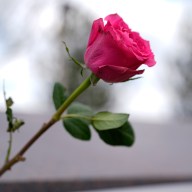 One of “The Double”‘s two Jesse Eisenbergs takes Mia Wasikowska on a date.
One of “The Double”‘s two Jesse Eisenbergs takes Mia Wasikowska on a date.
Credit: Dean Rogers
Not all of the directors in MoMA and the Lincoln Center’s annual New Directors/New Films series are new; a few are on their second, even third film. But they’re relatively still new at their jobs, and the series, as ever, captures exciting, promising and even already great artists when they’re still wet behind the ears. Here’s a few films worth putting in your schedule.
‘The Double’
England’s Richard Ayoade was once the nasal-voiced nerd on “The IT Crowd” (among other British comic greats). But look at him now — he’s doing Dostoevsky. Granted, it’s a loose, quasi-comic take on his novella, concerning a meek government clerk (Jesse Eisenberg) who dreams up a more confident version of himself (Jesse Eisenberg). It’s more Kafka than the Russian legend; set in a vaguely Eastern European purgatory of Ayoade’s devising, it’s an anxious machine of rust and creaks and comic-sinister superiors. Though Eisenberg is a scream as his alter ego, his director (“Submarine”) is less sure with the actual text, which too often feels like yet another tale about a sad manchild enamored with an unobtainable dream girl (Mia Wasikowska).
‘Return to Homs’
If “The Square,” about the Egyptian Revolution, stirs you up, “Return to Homs” will bring you down. Talal Derki’s first-person account of the Syrian Civil War witnesses a revolution in the titular city that’s quickly stomped into tiny fragments scattering about for shelter inside destroyed buildings. The hope comes in songs and the participants’ fierce dedication, though the film is most useful as a look at revolution at its lowest morale, and still kicking anyway.
‘A Spell to Ward off the Darkness’
Two of avant-garde cinema’s most ascetic titans — landscape surveyors Ben Russell and Ben Rivers — team up for this triptych that moves from a commune to remote nature to, of all places, a death metal show. (It makes perfect sense in context.) The general subject is man’s return to nature, and how it’s always a compromised effort, from the post-modern hippies who try to pretend they’re cool with orgies to our silent protagonist struggling to not read gossip magazines while playing Thoreau in the wildnerness. The tone is mind-clearing and contemplative, even — especially, actually — during a roaming long take close-up of our mysterious hero on stage.
‘The Strange Colors of Your Body’s Tears’
Helene Cattet and Bruno Forzani love the Italian ’giallo slashers of the ’70s, but their films (“Amer”) aren’t straight-up homages. They’re abstractions that reduce the genre to its base elements — loud colors, blades running down bodies and/or cutting them, electrifying music — then stretch them out over feature length. Their second film is a nonsensical murder mystery that is all image and sound overkill, shuffling the same handful of items on infinite repeat. It’s tension then ecstasy over and over, a maddening reduction ad absurdum of both ’giallos and homages in general that, if anything, makes them more exciting as artists.
‘To Kill a Man’
An art house “Death Wish,” Alejandro Fernandez Almendras’ drama tracks one bullied schlemiel’s journey to do away with the brute who’s been terrorizing him, his kids and his ex-wife, mostly to prove his manliness and self-worth. This isn’t the first time long master take cinema has been used to watch murder — the Romanian “Aurora” does it for serial killers — and Almendras has watched enough of them to use the style for deadpan, dark comedy.
‘The Vanquishing of the Witch Baba Yaga’
Similar to “A Spell to Ward off the Darkness,” Jessica Oreck’s fragmented whatzit ruminates over the death of fables and mystery in a modern world that’s come to believe in different, less imaginative and far more constricting myths. (Still: medicine. And iPods.) Using an animated telling of the Baba Yaga story as its base, it gets into Godfrey Reggio territory as it laments technology and traffic and cities, pining for a pre-civilization openness that’s disappeared. It’s unabashed hippieness with the right gnomic quotes to set the mind wandering, though Oreck doesn’t quite yet have the chops to beat this into a truly cosmic shape.
If you go:
New Directors/New Films
Through March 30
Museum of Modern Art and The Film Society of Lincoln Center
www.newdirectors.org















